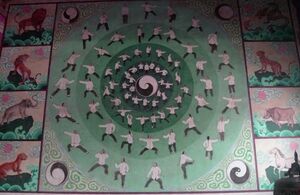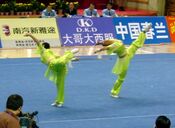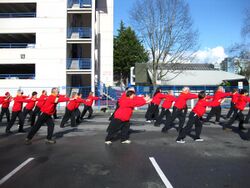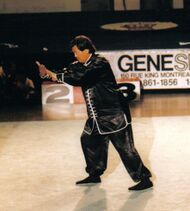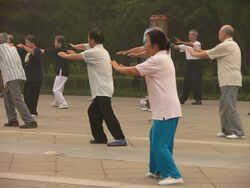Unsolved:Tai chi
| Tai chi |
|---|
Tai chi is an internal Chinese martial art practiced for self-defense and health. Known for its slow, intentional movements, tai chi has practitioners worldwide and is particularly popular as a form of gentle exercise and moving meditation, with benefits to mental and physical health.
Many forms of tai chi are practiced, both traditional and modern. While the precise origins are not known, the earliest documented practice is from Chen Village, Henan. Most modern styles trace their development to the five traditional schools: Chen, Yang, Wu (Hao), Wu, and Sun. Practitioners such as Yang Chengfu and Sun Lutang in the early 20th century promoted the art for its health benefits.[1] Tai chi was included in the UNESCO List of Intangible Cultural Heritage of Humanity in 2020.[2]
Etymology
The name "tai chi", the most common English spelling, is not a standard romanization of the Chinese name for the art (simplified Chinese: 太极拳; traditional Chinese: 太極拳; literally: 'Taiji boxing'). The Chinese name was first commonly written in English using the Wade–Giles system as "tTemplate:Wg-aposai chi chTemplate:Wg-aposüan". But English speakers abbreviated it to "tTemplate:Wg-aposai chi" and dropped the mark of aspiration. Since the late twentieth century, pinyin has replaced Wade–Giles as the most popular system for romanizing Chinese. In pinyin, tai chi is spelled taijiquan (tàijíquán).[3][4] In English, tai chi is sometimes referred to as "shadowboxing".[5]
| Characters | Wade–Giles | Pinyin | Meaning |
|---|---|---|---|
| 太極 | tTemplate:Wg-aposai chi | tàijí | Taiji, the cosmological relationship of Yin and Yang |
| 拳 | chTemplate:Wg-aposüan | quán | fist, or boxing |
The etymology of tai chi's Chinese name is somewhat uncertain because of the lack of a record of spoken usage. Before the mid-nineteenth century, it appears that outsiders generically described the art as zhanquan (沾拳, "touch boxing"), "Long Boxing"(長拳),[note 1] mianquan ("Soft/Cotton/Neutralizing Boxing"; 軟/棉/化拳)[citation needed] or shisan shi (十三式, "the thirteen techniques").[6] In the mid-nineteenth century, the art began to be associated with the philosophy of taiji (see Conceptual background).[7] This association may have originated in the writings of the founders of Wu (Hao)-style tai chi, perhaps inspired by a tai chi classic attributed to the semi-mythical Wang Zongyue that begins with the words "Taiji is born from Wuji; it is the mother of Yin and Yang".[note 2] However, as the Wu (Hao) founders had no financial need to promote their art, their contributions to the "tai chi classics" were not distributed widely for many years. The first public association between taiji and the art was a poem by Imperial Court scholar Weng Tonghe describing a tai chi performance by Yang Luchan.[9][10][11][12] It is not clear whether Weng was making a new connection or whether the new name was already in use. Written evidence for the Yang family's adoption of the name taiji first appeared in a later text, possibly completed in 1875 by Yang Luchan's son, Yang Banhou, or no later than the first decade of the twentieth century by one or more of Yang Banhou's disciples.[13][14][15][11] By the second decade of the twentieth century, Yang Chengfu's disciples and Sun Lutang were using the term taijiquan in their publications, including in the titles of some of the tai chi classics. It then appeared in a book by a Chen family member, Chen Xin, published after he died in 1929.[9][16]
Philosophical background
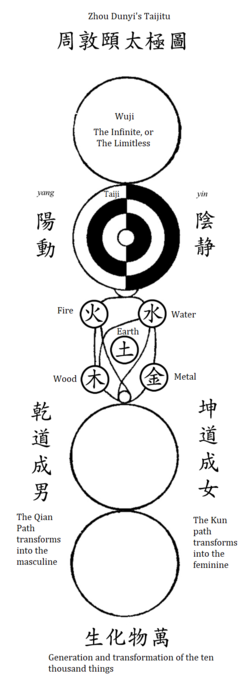
Chinese philosophy, particularly Taoist and Confucian thought, forms the conceptual background to tai chi.[17] Early tai chi texts include embedded quotations from early Chinese classics like the I Ching, Great Learning, Book of Documents, Records of the Grand Historian, and Zhuangzi, as well as from famous Chinese thinkers like Zhu Xi, Zhou Dunyi, and Mencius.[17]
Early tai chi sources are grounded in Taiji cosmology. Taiji cosmology appears in both Taoist and Confucian philosophy, where it represents the single source or mother of yin and yang (represented by the taijitu symbol ![]() ).[18][17] Tai chi also draws on Chinese theories of the body, particularly Taoist neidan (internal alchemy) teachings on qi (vital energy) and on the three dantian. Cheng Man-ch'ing emphasizes the Taoist background of tai chi and states that it "enables us to reach the stage of undifferentiated pure yang, which is exactly the same as Laozi's 'concentrating the qi and developing softness'".[17]
).[18][17] Tai chi also draws on Chinese theories of the body, particularly Taoist neidan (internal alchemy) teachings on qi (vital energy) and on the three dantian. Cheng Man-ch'ing emphasizes the Taoist background of tai chi and states that it "enables us to reach the stage of undifferentiated pure yang, which is exactly the same as Laozi's 'concentrating the qi and developing softness'".[17]
As such, tai chi considers itself an "internal" (neijia) martial art focused on developing qi.[17] In China, tai chi is categorized under the Wudang group of Chinese martial arts[19]—that is, arts applied with internal power.[20] Although the term Wudang suggests these arts originated in the Wudang Mountains, it is used only to distinguish the skills, theories, and applications of neijia from those of the Shaolin grouping, or waijia (hard/external styles).[17]
Tai chi also adopts the Taoist ideals of softness overcoming hardness, of wu wei (effortless action), and of yielding into its martial art technique while also retaining Taoist ideas of spiritual self-cultivation.[17]
Tai chi's path is one of developing naturalness by relaxing, attending inward, and slowing mind, body, and breath.[17] This allows the practitioner to become less tense, to drop conditioned habits, to let go of thoughts, to allow qi to flow smoothly, and thus to flow with the Tao. It is thus a kind of moving meditation that allows us to let go of the self and experience no-mind (wuxin) and spontaneity (ziran).[17]
A key aspect of tai chi philosophy is to work with the flow of yin (softness) and yang (hardness) elements. When two forces push each other with equal force, neither side moves. Motion cannot occur until one side yields. Therefore, a key principle in tai chi is to avoid using force directly against force (hardness against hardness). Laozi provided the archetype for this in the Tao Te Ching when he wrote, "The soft and the pliable will defeat the hard and strong."[21] Conversely, when in possession of leverage, one may want to use hardness to force the opponent to become soft. Traditionally, tai chi uses both soft and hard. Yin is said to be the mother of Yang, using soft power to create hard power.
Traditional schools also emphasize that one is expected to show wude ("martial virtue/heroism"), to protect the defenseless, and to show mercy to one's opponents.[1]
In December 2020, the 15th regular session of the UNESCO Intergovernmental Committee for the Safeguarding of the Intangible Cultural Heritage included tai chi in the UNESCO Representative List of the Intangible Cultural Heritage of Humanity.[22]
Practice
Traditionally, the foundational tai chi practice consists of learning and practicing a specific solo forms or routines (taolu).[17] This entails learning a routine sequence of movements that emphasize a straight spine, abdominal breathing and a natural range of motion. Tai chi relies on knowing the appropriate change in response to outside forces, as well as on yielding to and redirecting an attack, rather than meeting it with opposing force.[23] Physical fitness is also seen as an important step towards effective self-defense.
Tai chi movements were inspired by animals, "particularly...birds and" leopards.[24]
There are also numerous other supporting solo practices such as:[17]
- Sitting meditation: The empty, focus and calm the mind and aid in opening the microcosmic orbit.
- Standing meditation (zhan zhuang) to raise the yang qi
- Qigong to mobilize the qi
- Acupressure massage to develop awareness of qi channels
- Traditional Chinese medicine is taught to advanced students in some traditional schools.[25]
Further training entails learning tuishou (push hands drills), sanshou (striking techniques), free sparring, grappling training, and weapons training.[17]
In the "tai chi classics", writings by tai chi masters, it is noted that the physiological and kinesiological aspects of the body's movements are characterized by the circular motion and rotation of the pelvis, based on the metaphors of the pelvis as the hub and the arms and feet as the spokes of a wheel. Furthermore, the respiration of breath is coordinated with the physical movements in a state of deep relaxation, rather than muscular tension, in order to guide the practitioners to a state of homeostasis.
Tai chi is a complete martial art system with a full range of bare-hand movement sets and weapon forms, such as tai chi sword and tai chi spear, which are based on the dynamic relationship between yin and yang. While tai chi is typified by its slow movements, many styles (including the three most popular: Yang, Wu, and Chen) have secondary, faster-paced forms. Some traditional schools teach martial applications of the postures of different forms (taolu).
Solo practices
Taolu (solo "forms") are choreographed sets of movements practiced alone or in unison as a group. Tai chi is often characterized by slow movements in Taolu practice, and one of the reasons is to develop body awareness. Accurate, repeated practice of the solo routine is said to retrain posture, encourage circulation throughout students' bodies, maintain flexibility, and familiarize students with the martial sequences implied by the forms. Usually performed standing, solo forms have also been adapted for seated practice.[26]
Weapon practice
Tai chi practices involving weapons also exist. Weapons training and fencing applications often employ:
- the jian, a straight double-edged sword, practiced as taijijian;
- the dao, a heavier curved saber, sometimes called a broadsword;
- the tieshan, a folding fan, also called shan and practiced as taijishan;
- the gun, a 2 m long wooden staff and practiced as taijigun;
- the qiang, a 2 m long spear or a 4 m long lance.
More exotic weapons include:
- the large dadao and podao sabres;
- the ji, or halberd;
- the cane;
- the sheng biao, or rope dart;
- the sanjiegun, or three sectional staff;
- the feng huo lun, or wind-and-fire wheels;
- the lasso;
- the whip, chain whip and steel whip.
History
Early development
Tai chi's formative influences came from practices undertaken in Taoist and Buddhist monasteries, such as Wudang, Shaolin and The Thousand Year Temple in Henan.[27] The early development of tai chi proper is connected with Henan's Thousand Year Temple and a nexus of nearby villages: Chen Village, Tang Village, Wangbao Village, and Zhaobao Town. These villages were closely connected, shared an interest in the martial arts and many went to study at Thousand Year Temple (which was a syncretic temple with elements from the three teachings).[27] New[clarify] documents from these villages, mostly dating to the 17th century, are some of the earliest sources for the practice of tai chi.[27]
Some traditionalists claim that tai chi is a purely Chinese art that comes from ancient Taoism and Confucianism.[17] These schools believe that tai chi theory and practice were formulated by Taoist monk Zhang Sanfeng in the 12th century. These stories are often filled with legendary and hagiographical content and lack historical support.[17][27]
Modern historians point out that the earliest reference indicating a connection between Zhang Sanfeng and martial arts is actually a 17th-century piece called Epitaph for Wang Zhengnan (1669), composed by Huang Zongxi (1610–1695).[7][17] Aside from this single source, the other claims of connections between tai chi and Zhang Sanfeng appeared no earlier than the 19th century.[7][17] According to Douglas Wile, "there is no record of a Zhang Sanfeng in the Song Dynasty (960–1279), and there is no mention in the Ming (1368–1644) histories or hagiographies of Zhang Sanfeng of any connection between the immortal and the material arts."[17]
Another common theory for the origin of tai chi is that it was created by Chen Wangting (1580–1660) while living in Chen Village (陳家溝), Henan.[28] The other four contemporary traditional tai chi styles (Yang, Sun, Wu and Wu/Hao) trace their teachings back to Chen village in the early 1800s.[1][29]
Yang Luchan (1799–1872), the founder of the popular Yang style, trained with the Chen family for 18 years before he started to teach in Beijing, which strongly suggests that his work was heavily influenced by the Chen family art. Martial arts historian Xu Zhen claimed that the tai chi of Chen Village was influenced by the Taizu changquan style practiced at nearby Shaolin Monastery, while Tang Hao thought it was derived from a treatise by Ming dynasty general Qi Jiguang, Jixiao Xinshu ("New Treatise on Military Efficiency"), which discussed several martial arts styles including Taizu changquan.[30][31]
Standardization
In 1956 the Chinese government sponsored the Chinese Sports Committee (CSC), which brought together four wushu teachers to truncate the Yang family hand form to 24 postures. This was an attempt to standardize tai chi for wushu tournaments as they wanted to create a routine that would be much less difficult to learn than the classical 88 to 108 posture solo hand forms.
Another 1950s form is the "97 movements combined tai chi form", which blends Yang, Wu, Sun, Chen, and Fu styles.
In 1976, they developed a slightly longer demonstration form that would not require the traditional forms' memory, balance, and coordination. This became the "Combined 48 Forms" that were created by three wushu coaches, headed by Men Hui Feng. The combined forms simplified and combined classical forms from the original Chen, Yang, Wu, and Sun styles. Other competitive forms were designed to be completed within a six-minute time limit.
In the late 1980s, CSC standardized more competition forms for the four major styles as well as combined forms. These five sets of forms were created by different teams, and later approved by a committee of wushu coaches in China. These forms were named after their style: the "Chen-style national competition form" is the "56 Forms". The combined forms are "The 42-Form" or simply the "Competition Form".
In the 11th Asian Games of 1990, wushu was included as an item for competition for the first time with the 42-Form representing tai chi. The International Wushu Federation (IWUF) applied for wushu to be part of the Olympic games.[32]
Tai chi was added to the UNESCO Intangible Cultural Heritage Lists in 2020 for China.[33]
Styles
Chinese origin
The five major styles of tai chi are named for the Chinese families who originated them:
- Chen style (陳氏) of Chen Wangting (1580–1660)
- Yang style (楊氏) of Yang Luchan (1799–1872)
- Wu/Hao style (武郝氏) of Wu Yuxiang (1812–1880) and Hao Weizhen (1842–1920)
- Wu style (吳氏) of Wu Quanyou (1834–1902) and his son Wu Jianquan (1870–1942)
- Sun style (孫氏) of Sun Lutang (1861–1932)
The most popular is Yang, followed by Wu, Chen, Sun, and Wu/Hao.[17] The styles share underlying theory, but their training differs.
Dozens of new styles, hybrid styles, and offshoots followed, although the family schools are accepted as standard by the international community. Other important styles are Zhaobao tai chi, a close cousin of Chen style, which is recognized by Western practitioners; Fu style, created by Fu Zhensong, which evolved from Chen, Sun and Yang styles, and incorporates movements from baguazhang;[citation needed] and Cheng Man-ch'ing style, which simplifies Yang style.
Around the world in the 20th and 21st centuries, some Chinese emigrants who had learned tai chi in China continued to practice it together in their new communities.[citation needed]
North America
United States
Choy Hok Pang, a disciple of Yang Chengfu, was the first known proponent of tai chi to openly teach in the United States, beginning in 1939. His son and student Choy Kam Man emigrated to San Francisco from Hong Kong in 1949 to teach tai chi in Chinatown. Choy Kam Man taught until he died in 1994.[34][35]
Sophia Delza, a professional dancer and student of Ma Yueliang, performed the first known public demonstration of tai chi in the United States at the New York City Museum of Modern Art in 1954. She wrote the first English language book on tai chi, T'ai-chi Ch'üan: Body and Mind in Harmony, in 1961. She taught regular classes at Carnegie Hall, the Actors Studio, and the United Nations .[36][37]
Cheng Man-ch'ing opened his school Shr Jung tai chi after he moved to New York from Taiwan in 1964. Unlike the older generation of practitioners, Cheng was cultured and educated in American ways,[clarification needed] and thus was able to transcribe Yang's dictation into a written manuscript that became the de facto manual for Yang style. Cheng felt Yang's traditional 108-movement form was unnecessarily long and repetitive, which makes it difficult to learn.[citation needed] He thus created a shortened 37-movement version that he taught in his schools. Cheng's form became the dominant form in the eastern United States until other teachers immigrated in larger numbers in the 1990s. He taught until his death in 1975.[38]
Canada
Moy Lin-shin arrived in Toronto, Ontario, Canada from China in 1970, where he started teaching tai chi and related internal arts.[39]
Europe
United Kingdom
Norwegian Pytt Geddes was the first European to teach tai chi in Britain, holding classes at The Place in London in the early 1960s. She had first encountered tai chi in Shanghai in 1948, and studied with Choy Hok Pang and his son Choy Kam Man (who both also taught in the United States) while living in Hong Kong in the late 1950s.[40]
Yin and yang
More traditional practitioners hold that the two aspects of health and martial arts make up the art's yin and yang. The "family" schools present their teachings in a martial art context, whatever the intention of their students.[41]
Health
Tai chi's health training concentrates on relieving stress on the body and mind. In the 21st century, tai chi classes that purely emphasize health are popular in hospitals, clinics, community centers and senior centers. Tai chi's low-stress training method for seniors has become better known.[42]
Clinical studies exploring tai chi's effect on specific diseases and health conditions exist, though there are insufficient studies with consistent approaches to generate a comprehensive conclusion.[43]
Tai chi has been promoted for treating various ailments, and is supported by the Parkinson's Foundation and Diabetes Australia, among others. However, medical evidence of effectiveness is lacking.[44][45] A 2017 systematic review found that it decreased falls in older people.[46]
A 2011 comprehensive overview of systematic reviews of tai chi recommended tai chi to older people for its physical and psychological benefits. It found possitive results for fall prevention and overall mental health. No conclusive evidence showed benefit for most of the conditions researched, including Parkinson's disease, diabetes, cancer and arthritis.[44]
A 2015 systematic review found that tai chi could be performed by those with chronic medical conditions such as chronic obstructive pulmonary disease, heart failure, and osteoarthritis without negative effects, and found favorable effects on functional exercise capacity.[47]
In 2015 the Australian Government's Department of Health published the results of a review of alternative therapies that sought to identify any that were suitable for coverage by health insurance. Tai chi was one of 17 therapies evaluated. The study concluded that low-quality evidence suggests that tai chi may have some beneficial health effects when compared to control in a limited number of populations for a limited number of outcomes.[45]
A 2020 review of 13 studies found that tai chi had positive effect on the quality of life and depressive symptoms of older adults with chronic conditions who lived in community settings.[48]
In 2022, the U.S.A agency the National Institutes of Health published an analysis of various health claims, studies and findings. They concluded the evidence was of low quality, but that it appears to have a small positive effect on quality of life.[49]
Sport and self-defense
As a martial art, tai chi emphasizes defense over attack and replies to hard with soft. The ability to use tai chi as a form of combat is the test of a student's understanding of the art. This is typically demonstrated via competition with others.
Practitioners test their skills against students from other schools and martial arts styles in tuishou ("pushing hands") and sanshou competition.
See also
References
Notes
Citations
- ↑ 1.0 1.1 1.2 Wile 1996.
- ↑ "Tai Chi now on Unesco's intangible heritage list". https://www.scmp.com/video/china/3114494/chinese-martial-art-tai-chi-added-unescos-intangible-cultural-heritage-list.
- ↑ Bacher, Bob (2022). "Tai Chi? T'ai Chi? or Taiji?". https://dochenstyletaichi.com/tai-chi-chuan-tai-chi-chuan-taijiquan/.
- ↑ Margalit Fox (14 January 2017). "Zhou Youguang, Who Made Writing Chinese as Simple as ABC, Dies at 111". The New York Times. https://www.nytimes.com/2017/01/14/world/asia/zhou-youguang-who-made-writing-chinese-as-simple-as-abc-dies-at-111.html.
- ↑ Defoort, Carine (2001). "Is There Such a Thing as Chinese Philosophy Arguments of an Implicit Debate". Philosophy East and West 51 (3): 404. doi:10.1353/pew.2001.0039. https://lirias.kuleuven.be/handle/123456789/538453. "Just as Shadowboxing (taijiquan) is having success in the West"."Wudang Martial Arts". China Daily. 2010-06-17. https://www.chinadaily.com.cn/m/hubei/2010-06/17/content_9985740.. "Wudang boxing includes boxing varieties such as Taiji (shadowboxing)"Bai Shuping (白淑萍) (2009). Taiji Quan (Shadow Boxing), Bilingual English-Chinese. Beijing University Press. ISBN 9787301053911.
- ↑ Michael P. Garofalo (2021). "Thirteen Postures of Taijiquan". http://www.egreenway.com/taichichuan/powers13.htm.
- ↑ 7.0 7.1 7.2 Henning, Stanley (1994). "Ignorance, Legend and Taijiquan". Journal of the Chen Style Taijiquan Research Association of Hawaii 2 (3). http://www.nardis.com/~twchan/henning.html. Retrieved 2009-11-23.
- ↑ Wang Zongyue (attributed), Taijiquan Jing
- ↑ 9.0 9.1 Davis 2004, p. 38-40
- ↑ Wile 1996, p. 20
- ↑ 11.0 11.1 Li Jianqing, p. 37-38
- ↑ Yang Zhenji (杨振基) (1993). Yang Chengfu Style Taijiquan. 广西民族出版社 (Guangxi Minzu Publishing). 前言 (Introduction). ISBN 7-5363-1984-3.
- ↑ Davis 2004, 3840.
- ↑ Yang Banhou 1875
- ↑ Wile 1996, pp. 57–89, 135–153.
- ↑ Sun Lutang 1921
- ↑ 17.00 17.01 17.02 17.03 17.04 17.05 17.06 17.07 17.08 17.09 17.10 17.11 17.12 17.13 17.14 17.15 17.16 17.17 Wile, Douglas (2007). "Taijiquan and Daoism: From Religion to Martial Art and Martial Art to Religion". Journal of Asian Martial Arts (Via Media Publishing) 16 (4): 8–45. ISSN 1057-8358. http://blackmoonharbor.com/uploads/1/1/5/3/115363763/taijiquan_and_daoism_.pdf.
- ↑ Cheng Man-ch'ing (1993). Cheng-Tzu's Thirteen Treatises on T'ai Chi Ch'uan. North Atlantic Books. p. 21. ISBN 978-0-938190-45-5.
- ↑ Sun Lutang (2000). Xing Yi Quan Xue. Unique Publications. p. 3. ISBN 0-86568-185-6.
- ↑ Ranne, Nabil (2010). "Internal power in Taijiquan" (in de). CTND. http://www.ctnd.de/wissenswertes/36/88-kraft-taijiquantqj-2010.html.
- ↑ Laozi (attributed) (249). "七十六章". in Wang Bi. Tao Te Ching. "強大處下柔弱處上"
- ↑ ((Intergovernmental Committee for the Safeguarding of the Intangible Cultural Heritage)) (2020), Decision of the Intergovernmental Committee: 15.COM 8.b.21, UNESCO, https://ich.unesco.org/en/Decisions/15.COM/8.b.21, retrieved 2023-07-04
- ↑ Wong Kiew Kit (1996). The Complete Book of Tai Chi Chuan: A Comprehensive Guide to the Principles. Element Books Ltd. ISBN 978-1-85230-792-9.
- ↑ Clayre, Alasdair (1985). The Heart of the Dragon (First American ed.). Boston: Houghton Mifflin. pp. 43. ISBN 978-0-395-35336-3.
- ↑ Wu, Kung-tsao (2006). Wu Family T'ai Chi Ch'uan (吳家太極拳). Chien-ch'uan T'ai-chi Ch'uan Association. ISBN 0-9780499-0-X.[page needed]
- ↑ Quarta, Cynthia W. (2001). Tai Chi in a Chair (first ed.). Fair Winds Press. ISBN 1-931412-60-X. https://www.healingtaichi.com/. Retrieved 2018-08-20.
- ↑ 27.0 27.1 27.2 27.3 Wile, Douglas. 2016. ‘Fighting Words: Four New Document Finds Reignite Old Debates in Taijiquan Historiography’, Martial Arts Studies 4, 17–35.
- ↑ Chen, Mark (2004). Old frame Chen family Taijiquan. Berkeley, Calif.: North Atlantic Books : Distributed to the book trade by Publishers Group West. ISBN 978-1-55643-488-4.
- ↑ Wile, Douglas (1983). T'ai-chi Touchstones: Yang Family Secret Transmissions. Sweet Ch'i Press. ISBN 978-0-912059-01-3.
- ↑ Jarek Szymanski (1999). "Origins and Development of Taijiquan". http://www.chinafrominside.com/ma/taiji/TJQorigins.html.
- ↑ Jarek Szymanski (2000). "Taijiquan – Brief Analysis of Chen Family Boxing Manuals". http://www.chinafrominside.com/ma/taiji/chenboxingmanuals.html.
- ↑ "Wushu likely to be a "specially-set" sport at Olympics". Chinese Olympic Committee. October 17, 2006. http://en.olympic.cn/08beijing/bocog/2006-10-17/945504.html.
- ↑ "Taijiquan". UNESCO Culture Sector. https://ich.unesco.org/en/RL/taijiquan-00424.
- ↑ Choy, Kam Man (1985). Tai Chi Chuan. San Francisco: Memorial Edition 1994.[ISBN missing]
- ↑ Nick Harvey, ed (1970). Ting: The Caldron, Chinese Art and Identity in San Francisco. San Francisco: Glide Urban Center. ISBN 9780912078144.
- ↑ Dunning, Jennifer (July 7, 1996). "Sophia Delza Glassgold, 92, Dancer and Teacher". The New York Times. https://www.nytimes.com/1996/07/07/nyregion/sophia-delza-glassgold-92-dancer-and-teacher.html.
- ↑ "Inventory of the Sophia Delza Papers, 1908–1996". Jerome Robbins Dance Division, New York Public Library for the Performing Arts. February 2006. https://www.nypl.org/sites/default/files/archivalcollections/pdf/dandelza.pdf.
- ↑ Wolfe Lowenthal (1991). There Are No Secrets: Professor Cheng Man Ch'ing and His Tai Chi Chuan. North Atlantic Books. ISBN 978-1-55643-112-8. https://books.google.com/books?id=6ayJG1GU5Y4C.
- ↑ Scrivener, Leslie (September 9, 2007). "Marshalling praise for art of Tai Chi". The Toronto Star. https://www.thestar.com/article/254609.
- ↑ "Pytt Geddes (obituary)". The Daily Telegraph. 21 March 2006. https://www.telegraph.co.uk/news/main.jhtml?xml=/news/2006/03/21/db2101.xml.
- ↑ Woolidge, Doug (June 1997). "T'AI CHI". The International Magazine of T'ai Chi Ch'uan (Wayfarer Publications) 21 (3). ISSN 0730-1049.
- ↑ Yip, Y. L. (Autumn 2002). "Pivot – Qi". The Journal of Traditional Eastern Health and Fitness (Insight Graphics Publishers) 12 (3). ISSN 1056-4004.
- ↑ "Evidence base of clinical studies on Tai Chi: a bibliometric analysis". PLOS ONE 10 (3): e0120655. 2015. doi:10.1371/journal.pone.0120655. PMID 25775125. Bibcode: 2015PLoSO..1020655Y.
- ↑ 44.0 44.1 Lee, M. S.; Ernst, E. (2011). "Systematic reviews of t'ai chi: An overview". British Journal of Sports Medicine 46 (10): 713–8. doi:10.1136/bjsm.2010.080622. PMID 21586406.
- ↑ 45.0 45.1 Baggoley C (2015). "Review of the Australian Government Rebate on Natural Therapies for Private Health Insurance". Australian Government – Department of Health. http://www.health.gov.au/internet/main/publishing.nsf/content/0E9129B3574FCA53CA257BF0001ACD11/$File/Natural%20Therapies%20Overview%20Report%20Final%20with%20copyright%2011%20March.pdf.
- Lay summary in: Scott Gavura (November 19, 2015). "Australian review finds no benefit to 17 natural therapies". https://www.sciencebasedmedicine.org/australian-review-finds-no-benefit-to-17-natural-therapies.
- ↑ Lomas-Vega, R; Obrero-Gaitán, E; Molina-Ortega, FJ; Del-Pino-Casado, R (September 2017). "Tai Chi for Risk of Falls. A Meta-analysis.". Journal of the American Geriatrics Society 65 (9): 2037–2043. doi:10.1111/jgs.15008. PMID 28736853.
- ↑ Chen, Yi-Wen; Hunt, Michael A.; Campbell, Kristin L.; Peill, Kortni; Reid, W. Darlene (2015-09-17). "The effect of Tai Chi on four chronic conditions – cancer, osteoarthritis, heart failure and chronic obstructive pulmonary disease: a systematic review and meta-analyses" (in en). British Journal of Sports Medicine 50 (7): bjsports-2014-094388. doi:10.1136/bjsports-2014-094388. ISSN 1473-0480. PMID 26383108. http://bjsm.bmj.com/content/early/2015/09/04/bjsports-2014-094388. Retrieved 2015-10-09.
- ↑ Choo, YT (2020). "Effectiveness of tai chi on quality of life, depressive symptoms and physical function among community-dwelling older adults with chronic disease: a systematic review and meta-analysis". International Journal of Nursing Studies (Elsevier) 111: 103737. doi:10.1016/j.ijnurstu.2020.103737. PMID 32891966.
- ↑ ((National Center for Complementary and Intrgrative Health)) (March 2022). "Tai Chi: What You Need To Know". in Inna Belfer; Lanay Mudd; David Shurtleff. National Institutes of Health. https://www.nccih.nih.gov/health/tai-chi-what-you-need-to-know.
Further reading
Books
- Gaffney, David; Sim, Davidine Siaw-Voon (2014). The Essence of Taijiquan. CreateSpace Independent Publishing Platform. ISBN 978-1-5006-0923-8.
- Bluestein, Jonathan (2014). Research of Martial Arts. CreateSpace Independent Publishing Platform. ISBN 978-1-4991-2251-0.
- Yang, Yang; Grubisich, Scott A. (2008). Taijiquan: The Art of Nurturing, The Science of Power (2nd ed.). Zhenwu Publication. ISBN 978-0-9740990-1-9.
- Frantzis, Bruce (2007). The Power of Internal Martial Arts and Chi: Combat and Energy Secrets of Ba Gua, Tai Chi and Hsing-I. Blue Snake Books. ISBN 978-1-58394-190-4.
- Davis, Barbara (2004). Taijiquan Classics: An Annotated Translation. North Atlantic Books. ISBN 978-1-55643-431-0.
- Eberhard, Wolfram (1986). A Dictionary of Chinese Symbols: Hidden Symbols in Chinese Life and Thought. Routledge & Kegan Paul, London. ISBN 0-415-00228-1. https://archive.org/details/dictionaryofchin00wolf.
- Choy, Kam Man (1985). Tai Chi Chuan. San Francisco, California: Memorial Edition 1994.[ISBN missing]
- Agar-Hutton, Robert (2018), The Metamorphosis of Tai Chi: Created to kill; evolved to heal; teaching peace. Ex-L-Ence Publishing. ISBN 978-1-9164944-1-1
- Wile, Douglas (1983). Tai Chi Touchstones: Yang Family Secret Transmissions. Sweet Ch'i Press. ISBN 978-0-912059-01-3.
- Bond, Joey (1999). See Man Jump See God Fall: Tai Chi Vs. Technology. International Promotions Promotion Pub. ISBN 978-1-57901-001-0. https://books.google.com/books?id=3YPZ8qbRLdQC.
- Sun, Lutang (孫祿堂, 1921), 太極拳學 (A Study of Taiji Boxing), available online in Chinese with English translation on Scribd, and in print (Traditional Chinese, 2018) from 大展出版社有限公司 (Dah Jaan Publishing Inc.), ISBN:978-986-346-201-9 and (Simplified Chinese, 2016), in 孙禄堂武学集注 太极拳学 ("Sun Lutang Martial Theory Collection: A Study of Taiji Boxing"), Beijing, from 北京科学技术出版社 (Beijing Science and Technology Press), ISBN:9787530486252
- Li, Jianqing, Editor in Chief (李剑青, 主編, 2006), 永年太极拳志 (Yongnian Taijiquan Gazetteer), 人民体育出版社出版 (People's Sports Publishing House), ISBN:7-5009-3044-5.
- Yang, Banhou (楊班侯, 1875*), 太極法說 (Explaining Taiji Principles), available online in Chinese and English translation at Scribd and also included in Chinese and English translation in Wile, Douglas (1996) (*Scholars estimate the publication date to be between 1875 and 1910, and believe the author(s) to be Yang Banhou and/or his disciples)
- Wile, Douglas (1996). Lost T'a-Chi Classics from the Late Ch'ing Dynasty. State University of New York Press. ISBN 0-7914-2653-X.
Magazines
 |
